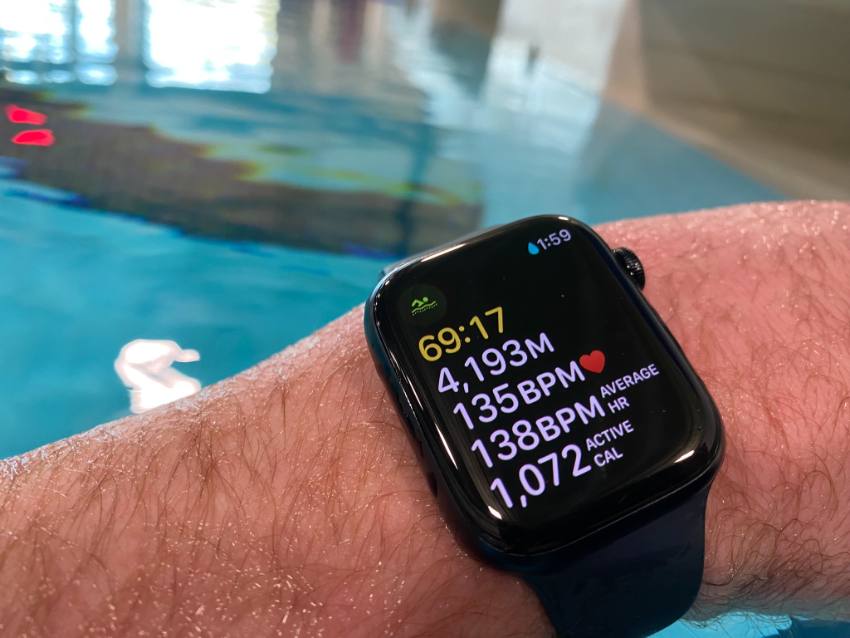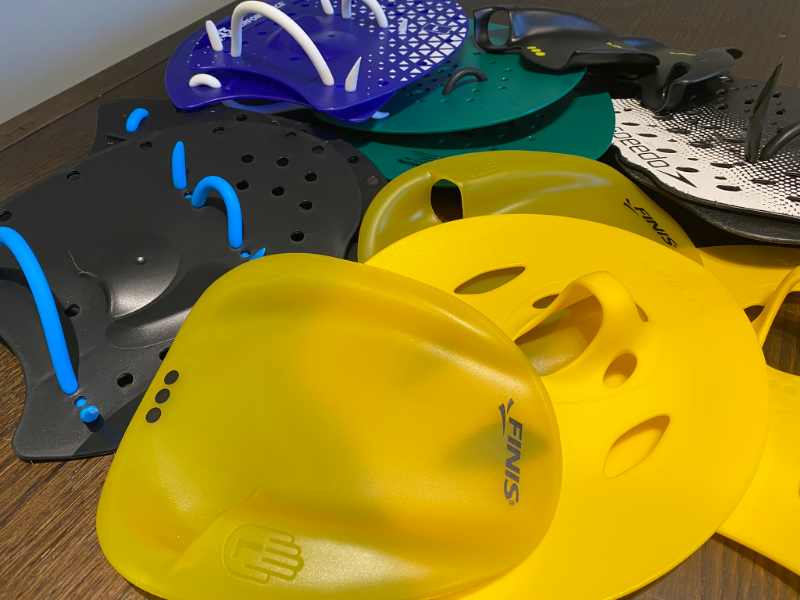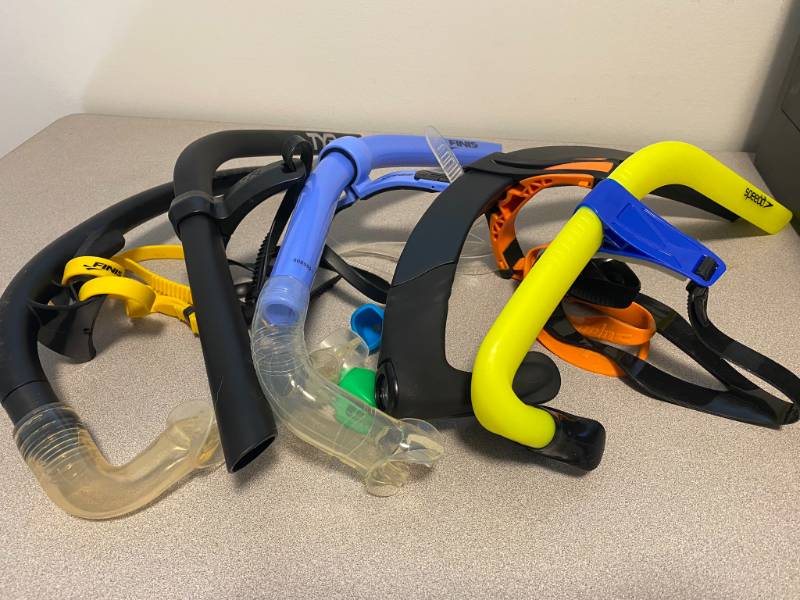Ready to take your swimming to another level? Dive into the essential types of swim training equipment for faster swimming.
Swimming is a relatively simple sport on the surface: strap on your favorite set of swim goggles and a swimsuit, and off you go.
But when it comes to improving swim performance, there is no shortage of swimming gear to upgrade swim strength, endurance, and technique.
Swim equipment like kickboards, pull buoys, fins, swim paddles, snorkels, and others can also help swimmers train around injuries and alleviate swim boredom.
In this guide to the essential types of swim training gear, we’ll examine the most popular (and effective!) forms of swim aids.
Let’s dive right in.
Essential Types of Swim Training Equipment
The essential types of training equipment for swimmers include:
- Swim goggles
- Swim watch
- Kickboard
- Pull buoy
- Swim paddles
- Swim fins
- Swim snorkel
- Swim parachute
- DragSox
- Ankle band
- Tempo Trainer
Next, we will examine each type of swim training equipment individually, looking at key pros and cons, and list some suggestions for implementing them for success in the water.
Swim Goggles
Swim goggles are one of the essential pieces of swim equipment for your workouts in the pool, whether you are a beginner or a seasoned Olympic champion.
Swim goggles help you see the pace clock, whether the large, sweeping hand of the analog clock on the wall at the pool or the splits and pace on your swim watch.
Goggles help you to time your turns, touch on a full stroke, protect your eyes from pool chemicals, reduce eye strain when swimming outdoors, and help you avoid swimming full-steam into other swimmers in your lane.
See also: The 9 Types of Swimming Goggles
Swim goggles are also a training aid, especially in the age of heads-up displays with real-time tracking.
Pioneered by FORM Swim Goggles, and later FINIS with their own Smart Goggles, swim goggles have gone from being a tool to see the pace clock to being the pace clock.
Swim Watch
Swim watches are wearable devices worn in the pool and open water to track and monitor swimming performance, giving you valuable data to help improve your swimming.
A swim watch automagically counts all of your laps for you (well, most of the time), ensuring that you accurately track the distance swum during your swimming workouts.
These devices track a metric (ha!) ton of other data points, including:
- Stroke count
- Stroke type
- Heart rate
- Average speed
- Average pace/100
- Splits
- Stroke rate
- Stroke efficiency (typically measured as a SWOLF score)
- GPS for open water tracking
- And more.
Swim watches have come a long way in recent years regarding tracking abilities. For example, the workout app on my Apple Watch is smarty-pants enough to know when I am kicking on a board.

Additionally, for swimmers who like guided workouts, many swim watches and the swimming apps they support include workouts and training plans that can be uploaded directly to your device.
Kickboard
Kickboards are the first swimming accessories we learn to use during our earliest days in the pool. Kickboards isolate the legs and lower body to improve kicking strength and endurance.
By gripping the board, swimmers learn to fully engage the quads, hips, core, and feet to generate propulsion with the lower body.
Spending more time on the kickboard helps swimmers develop the leg endurance required to execute a more efficient stroke, finish races with a full kick, and is a great tool for breaking up longer swimming sets and workouts.
Kickboards come in a variety of shapes and sizes, with your “classic” tombstone EVA foam board being the most popular (and the one that will always be at the end of my lane when I go for a swim).
Other types of kickboards include arrowhead boards, pull buoy and kickboard combo aids, and my favorite kickboard for “connecting” the kick to regular swimming, the FINIS alignment kickboard.
The right kickboard for your swimming comes down to buoyancy, ergonomics, board shape, and flex of the board.
Pull Buoy
Pull buoys are one of the classic swim training aids designed to help swimmers focus on the pull and upper body. Pull buoys are a type of floatation device, specifically curved and shaped to fit between the thighs, giving swimmers added buoyancy.
Pull buoys give swimmers an artificial sense of how a high hip position in the water feels and are an excellent tool for days when you want to focus on pull endurance in the pool.
Pull buoys can be used with paddles and an ankle band (or even resistance tools like a drag chute) to improve upper body strength in the water further.
A strong upper body is crucial for swimming fast; one study with elite competitive swimmers found that the upper body contributed 90% of propulsion during maximal velocity testing (Deschodt et al., 1999).
One odd aspect of swimming with a pull buoy is that it can often feel easier than full swimming (leading to being a crutch for some swimmers, ahem).
Swimming with a pull buoy feels easier because of the better body position and inactive legs dangling behind us.
Swim Paddles
Swim paddles, also known as hand training paddles, are a form of swimming equipment designed to enhance pulling strength and endurance.
The benefits of swim paddles include swim-specific power development, encouraging a stronger catch, and providing immediate feedback on whether you are using proper hand entry.
There are different types of swim paddles for different goals in the pool, including your classic “power” paddle (the most common type), finger-tip paddles, and anti-paddles.
See also: 9 Best Swim Paddles for Stronger and Faster Swimming
The standard swim paddle extends the hand’s surface area, helping swimmers get a better sense of how to catch the water and position the hands and fingers for maximum propulsion.

Swim paddles are a strength-development tool for swimmers that increase distance per stroke and help swimmers go faster, providing an opportunity to learn efficient body position (Gourgoulis et al., 2006).
Like all swim tools that create resistance and increase demand on the muscles and ligaments, use them progressively and avoid the urge to start with extra-large dinner plates on your hands.
A study published in the American Journal of Sports Medicine found that using swim paddles aggravated existing shoulder injuries in age group and national-level swimmers, so use this type of swimming equipment appropriately.
Swim Fins
Swim fins, also known as fins or flippers, are a type of swimming gear worn on the feet that increase propulsion, strengthen the legs, improve ankle flexibility, encourage better body position, and improve kicking technique.
And perhaps most important… using swim fins is FUN.
Who doesn’t like going Mach 5 across the length of the pool, tasting—even for just a few fleeting moments—the velocities of our swimming heroes?
Swim fins can be used in many ways to improve swim performance.
Some of my favorite ways to incorporate swim fins into my training include:
- Overspeed work to “learn” efficient body positioning at high-velocity speeds
- As part of my warm-up to decrease shoulder load
- With paddles to generate huge bow waves that swallow the lane rope
- Single-leg kicking to address leg kick imbalances
- With a chute for maximum effort underwaters for a more powerful underwater dolphin kick.
And on and on.
The best swim training fins for you come down to your budget, workout goals, and the fin material that suits you best.
Swim fins come in short and long blade versions. Short blade fins are a better option for more experienced swimmers looking to maintain kicking tempo that more accurately reflects regular kick tempo. Long fins provide a little more buoyancy and are better suited for beginners.
Fins are swimming accessories that swimmers love using and can help them swim faster.
Swim Snorkel
Swim snorkels have exploded in popularity in recent years, becoming an essential piece of swim gear for age group swimmers, Olympic champs, masters swimmers, and recreational swimmers.
Swim snorkels enable swimmers to keep their face down in the water, promoting a better body position. This helps swimmers achieve a more hydrodynamic body line in the water.
Using a swim snorkel is a great option for swimmers who train long course as it gives extended opportunities to develop proper stroke rhythm.

Rocking out with a swim snorkel when doing kick sets is also a great way to learn how to kick with proper body position.
Or when you want to do front sculling but don’t want to pick your head up like an otter to catch a breath.
The benefits of swim snorkels are too long to list in this article, but one of my favorites is that snorkels can help swim with proper freestyle technique.
A study with 18 competitive swimmers found that using a swim snorkel helped minimize excess hip roll at submaximal speeds, improving overall freestyle technique and mechanics.
See also: 8 Best Swimming Snorkels for Better Technique and Faster Swimming
Snorkels are one of the best tools for swimmers of all levels looking to improve swim technique and performance.
Swim parachute
Swim parachutes, also known as drag chutes, are resistance tools swimmers can use in the water to build strength and endurance that is highly swim-specific.
The chute dangles by a nylon cord behind you—which admittedly can get caught in the feet at times—creating extra drag that forces swimmers to work harder to get across the pool.
Using a swim parachute can help strengthen the catch phase of the pull, encourage better body position, and even help you balance out your stroke. Anecdotally, it’s also a great core workout as the trunk works overtime to maintain a straight body-line.
Studies done with experienced competitive swimmers (Telles et al., 2015, Telles et al., 2017) found that training with a swim parachute positively affected “propulsive continuity” in butterfly and backstroke, making it a great tool for developing a smoother stroke.
Swim parachutes are portable, easy to stash in your mesh bag, and are a great power-development tool for swimmers who train on their own or who don’t have access to power racks.
DragSox
DragSox are another training tool for swimmers that increases the resistance in the water and builds very swim-specific strength in the pool.
Also known as resistance swim socks, DragSox are mesh nets secured to the ankles and create extra drag as you move your feet through the water.
DragSox are an excellent option for swimmers who want to focus primarily on strengthening the kick. They function similarly to swim parachutes in that they increase resistance when doing full swimming, but personally, I find the “pull” effect stronger when using a chute.
DragSox don’t get tangled up in your feet and can be used for other kicking drills like vertical kicking.
Like drag chutes, DragSox are easy to travel with and are a great option for the solo swimmer looking to get stronger in the pool.
Ankle band
Ankle bands are a no-frills training aid that lock your feet into place when doing pull sets, eliminating any of the leg and foot movement that swimmers “accidentally” use when doing pull.
Bands remove the body’s natural urge to move the legs in rhythm with the arm stroke, which can lead swimmers to feel like someone tied a cinder block to their ankles. But with time, you’ll find that using a band encourages more core activation and a more efficient hip roll.
More advanced swimmers can also use bands without a pull buoy to really challenge them to maintain a high hip position in the water.
I’ve found that doing short-burst, full-intensity efforts with a band teaches a higher stroke rate, perfect for sprinters who find themselves stuck in low-gear stroke tempos.
Bands are a strength and power development aid in the pool, so start small and progress as you get stronger in the water.
FINIS Tempo Trainer
Finally, we have the FINIS Tempo Trainer, a swim tool for helping swimmers master stroke rate and tempo.
The device clips onto your swim goggle strap and emits a rhythmic beep or chirp at your desired cadence or tempo, helping swimmers maintain a consistent stroke rate in the water.
This can help swimmers prepare for competitive situations by teaching appropriate speed and pacing (i.e. not spinning your wheels on the first lap), fixing excess hitches or gallops in the stroke, and even teaching a more rhythmic breathing pattern.
The Tempo Trainer can encourage swimmers to lengthen their strokes or, in the case of over-gliders, to shorten things up and get into the catch quicker.
One of the ways I used the FINIS Tempo Trainer when I first tested it was as a pace clock; by setting it to go off at a specific interval, the device can be used like the old and dreaded Beep Test from elementary school.
Perfect for pools with hard-to-read or non-existent pace clocks.
For swimmers who don’t need all the bells and whistles of a swim watch or waterproof fitness tracker (or the price tag), the FINIS Tempo Trainer is an awesome piece of swim gear for more efficient swimming.
Wrapping Things Up
The right swim gear can help swimmers become stronger in the water, improve technique, and increase endurance. Swim gear can also help you train around injuries and eliminate a lot of the boredom of long, rote swim workouts.
Whether you are a beginner looking to swim your first mile or an experienced swimmer aiming for the top of the Olympic podium, choosing the right swim aids and tools can help you hit peak performance in the water.
Equip yourself for success in the water and take your swimming to new levels of chlorinated awesomeness.
More Swim Gear Articles:
7 Best Kids’ Swimming Goggles that are Comfortable and Don’t Leak
ABOUT OLIVIER POIRIER-LEROY
Olivier Poirier-Leroy is a former national-level swimmer, author, swim coach, and certified personal trainer. He’s the author of YourSwimBook, a ten-month logbook for competitive swimmers.
 He’s also the author of the recently published mental training workbook for competitive swimmers, Conquer the Pool: The Swimmer’s Ultimate Guide to a High-Performance Mindset.
He’s also the author of the recently published mental training workbook for competitive swimmers, Conquer the Pool: The Swimmer’s Ultimate Guide to a High-Performance Mindset.
It combines sport psychology research, worksheets, anecdotes, and examples of Olympians past and present to give swimmers everything they need to conquer the mental side of the sport.
Ready to take your mindset to the next level in the pool?
Click here to learn more about Conquer the Pool.

antipaddles also exist
Me wondering where “racquetball” is on the list